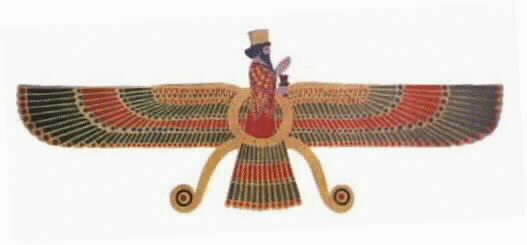|
|
|

The Faravahar, or Farohar, figure has a definite and deep significance. It reminds one of the purpose of life on this earth, which is to live in such a way that the soul progresses spiritually and attains union with Ahura-Mazda (the Wise Lord); this state is called Frasho-kereti in Avesta. In the center of the figure is a circle which represents the soul of the individual. For the soul to evolve and progress, it has two wings. In each wing there are five layers of feathers. These can represent the five Divine Songs (Gathas) of Zarathustra, the five divisions of the day (Gehs), and the five senses of the human body. In nature, there exist two opposing forces: Spenta-Mainyu the good mind or asare roshni and Angre-Mainyu the wicked mind or asare tariki. A continuous conflict goes on in nature between these two. A person's soul is caught between the two and is pulled by each from side to side. The two long curved legs on either side of the circle represent these two forces. To help the soul balance itself between these two forces, the soul is given a rudder in the form of a tail. This tail has three layers of feathers, which reminds one of the path of Asha Humata (Good Thoughts), Hukhta (Good Words), and Hvarasta (Good Deeds), or Manashni, Gavashni, and Kunashni by which the soul is able to make its own spiritual progress. The head of the figure reminds us that Ahura-Mazda has given every soul a free will to choose either to obey divine universal natural laws or to disobey them. The figure also has a pair of hands which hold a circular ring. The ring symbolizes the cycles of rebirths on this earth and other planes which the soul has to undergo to make progress on the path of Asha. If these divine laws are obeyed through Manashni, Gavashni, and Kunashni, our soul will be able to attain union with Ahura-Mazda. This far-off event, towards which the whole of creation moves, is called Frasho-kereti.